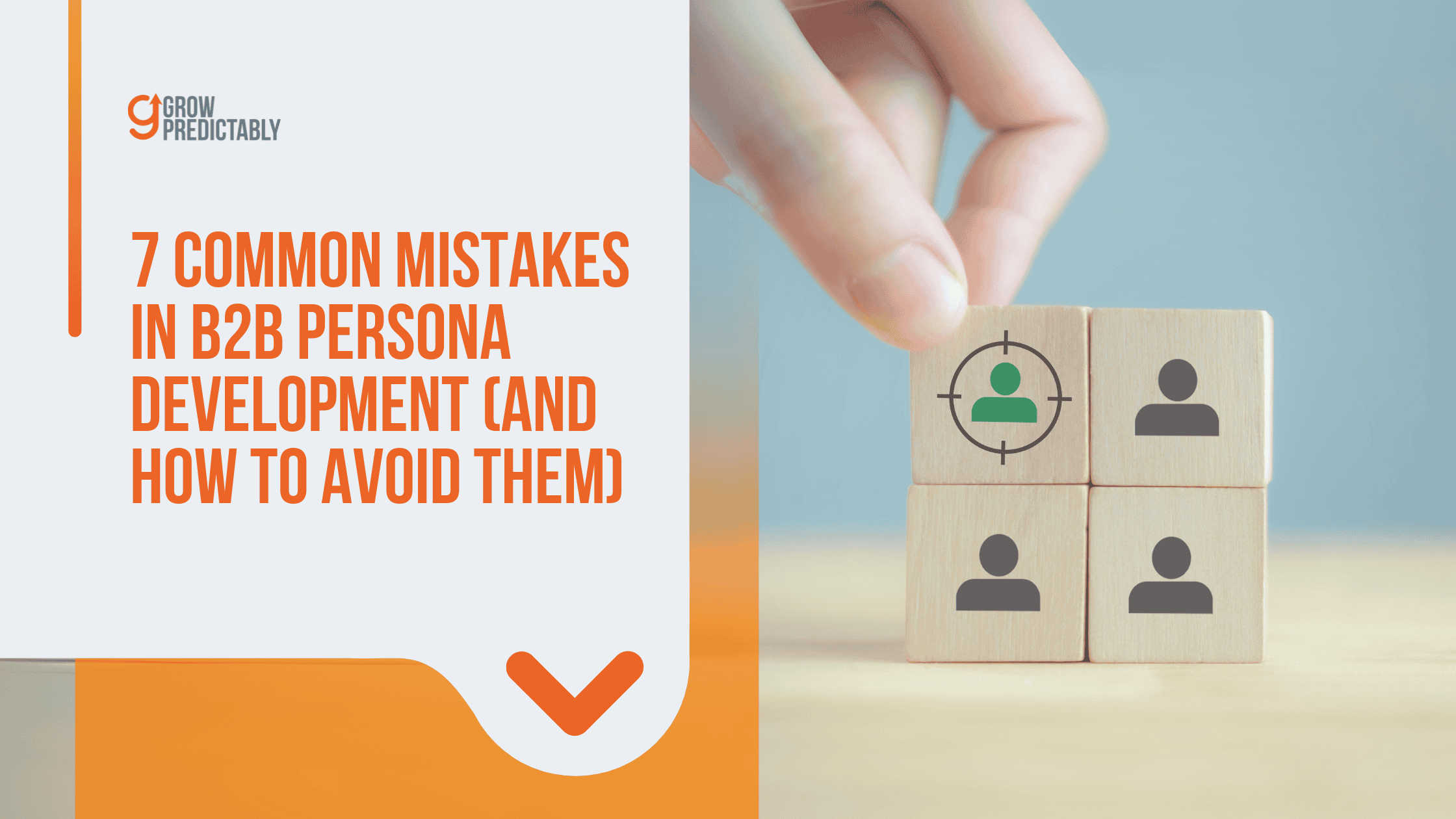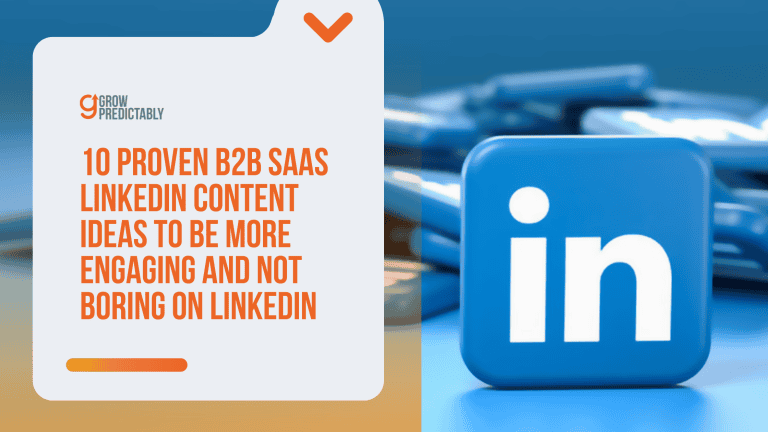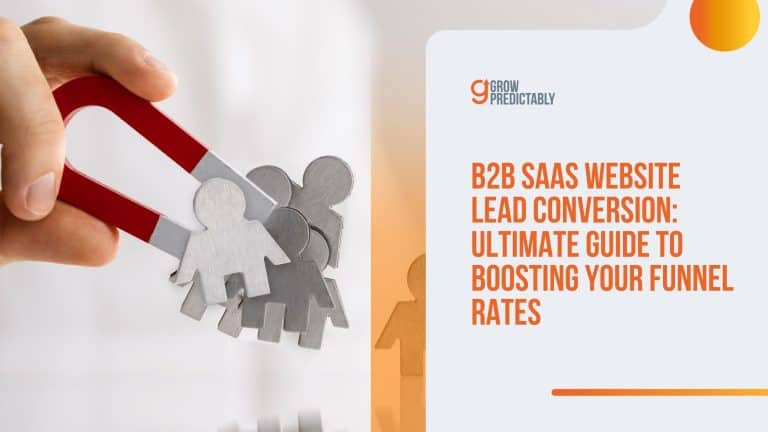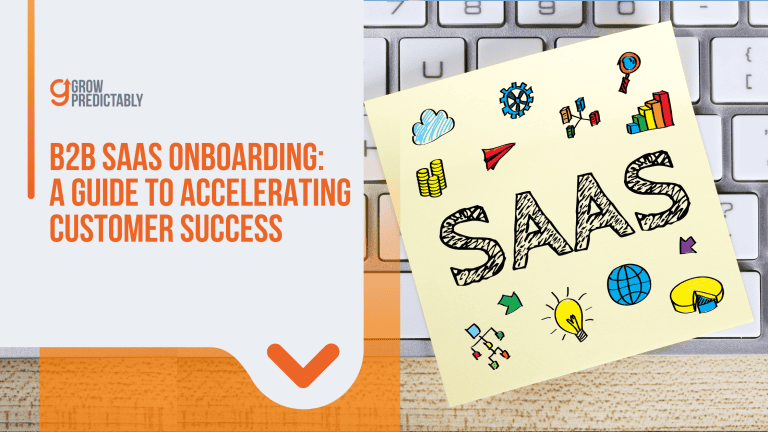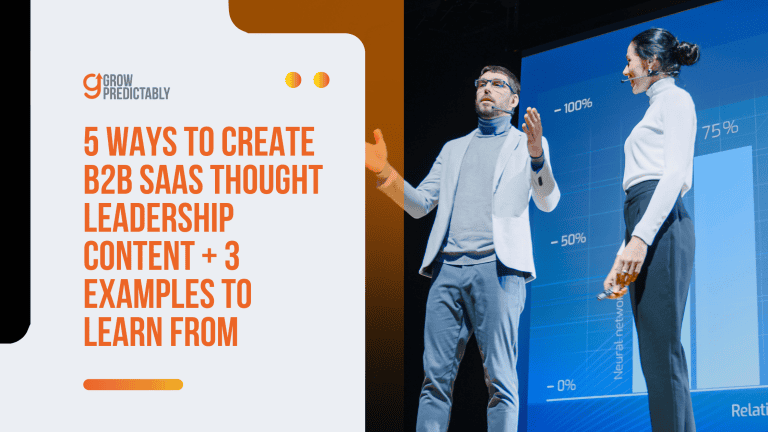7 Common Mistakes in B2B Persona Development (And How to Avoid Them)
You know your customers.
You’ve got personas.
But the conversions aren’t there—and neither is the engagement.
Here’s the problem: you’re targeting what someone does, not why they do it.
Too many personas can dilute your focus and resources, so it’s crucial to concentrate on a limited number of key B2B buyer personas.
When you fix this, your messaging starts hitting nerve endings, not just inboxes.
We’re breaking down the biggest mistakes in B2B persona development and how to dodge each one.
The first one is deadly—and nearly every team makes it.
Decoding B2B Personas: What They Are and Why They Matter

A B2B persona is a comprehensive profile that captures the essence of your ideal business customer.
It’s not just a generic outline; it’s a nuanced guide that helps you understand the people who make purchasing decisions within other companies.
It’s about pinpointing not just who they are, but what they care about, why they make the choices they do, and how they engage with your business.
- Demographics: Go beyond basic age and location; consider industry specifics, company size, and market segments. These elements help you understand their professional environment and typical challenges they might face.
- Role and Responsibilities: Detail what they do daily and their influence within the company. This information helps tailor your message and strategies to align with their professional priorities.
- Goals and Challenges: Pinpoint what success looks like for them and the obstacles they face. This understanding is key to crafting messages that resonate and highlight how your solution can help.
- Buying Behavior: Analyze how they gather information, the decision-makers involved, and budget constraints. Recognizing these patterns allows for the creation of targeted approaches that facilitate smoother sales processes.
Getting your personas right is essential for your marketing and sales to hit the mark.
They inform you how to design your strategies, ensuring you speak directly to the needs and desires of your potential customers.
A well-crafted persona allows you to move beyond generic outreach and engage your audience in meaningful, impactful ways.
Crafting Effective B2B Personas: A Step-by-Step Guide
Creating a B2B persona is a journey into understanding your customers on a granular level.
It’s about taking raw data and transforming it into a clear, actionable profile that represents the specific segment of your target audience.
This process ensures that every marketing and sales effort is perfectly aligned with the needs and challenges of your potential buyers.

1. Gather Data from Multiple Reliable Sources
Starting with solid data sets you up for success.
In the B2B world, guessing or using outdated info won’t cut it; it leaves you shooting in the dark.
You gain a rounded understanding of your clients by harnessing a mix of resources like CRM analytics, customer interviews, and feedback from your sales team.
This blend of data sheds light on not just the obvious aspects but also the subtle cues about buyer habits.
Having diverse data lets you build personas that truly reflect your audience, steering your strategies in the right direction.
- Utilize Social Listening: Monitor online discussions and forums to capture unfiltered customer opinions.
- Analyze Competitor Data: Study competitors’ audience interactions for additional insights into market expectations.
- Conduct Focus Groups: Gather a small group of customers for in-depth discussions about their needs and experiences.
2. Identify Key Demographics and Firmographics
Demographics and firmographics are like the basics of understanding your market map.
Knowing the industry, job roles, and company details of your target audience helps make your communication hit the mark.
It’s essential to tailor your outreach so it actually speaks to the people you want to engage with, rather than just broadcasting broadly.
Aligning your tactics with these key details creates messages that genuinely connect with your audience.
- Create Detailed Segmentation Maps: Visualize customer segments to understand different demographic layers better.
- Leverage Customer Satisfaction Surveys: Reveal firmographic preferences that might not be immediately obvious.
- Identify Growth Phases: Understand where companies are in their growth cycle, as this can affect their needs and spending.
3. Understand Their Goals and Challenges
Understanding your customers’ goals and the hurdles they face is key to delivering solutions that really matter.
If you know what they’re trying to achieve, you can tailor your approach to offer support that’s truly beneficial.
This builds trust and makes your product or service an appealing option when they’re looking for ways to overcome their obstacles.
The focus is on showing how you can help solve their real problems, which builds deeper relationships.
- Set Up Internal Workshops: Collaborate across departments to uncover universal goals and challenges.
- Use Case Studies: Analyze previous case studies to see how similar problems were solved.
- Conduct Job Shadowing: Spend a day in your persona’s shoes to truly understand their daily challenges.
4. Map Out Their Buying Behavior and Journey
Understanding how your personas make buying decisions allows you to meet them where they are in their journey.
By recognizing their buying patterns and journey steps, you can effectively guide them, reducing obstacles and helping them make decisions smoothly.
This understanding helps tailor your efforts at each stage to ensure they find what they need when they need it, making the buying process as seamless as possible.
- Develop Buyer Journey Maps: Visual tools that illustrate each step of the buying process.
- Interview Lost Leads: Gain insights into why some buyers didn’t convert and adjust strategies accordingly.
- Integrate Analytics Tools: Use software to track digital behavior and refine understanding of the buying journey.
5. Develop a Comprehensive Persona Profile
Creating a thorough persona profile turns all your collected insights into a usable portrait of your ideal customer.
This profile serves as a roadmap for your entire team, providing guidance that ensures everyone is aligned in their efforts.
When personas are detailed and relatable, they are not only useful for marketing but also inform product development and customer service, promoting a unified approach toward engaging your audience.
- Incorporate Visual Elements: Include images and graphics to make personas more engaging and memorable.
- Draft Empathy Maps: Identify what personas see, hear, think, and feel to deepen understanding.
- Use Interactive Tools: Employ digital persona tools that can be accessed and edited by relevant teams for real-time updates.
6. Regularly Update and Validate Your Personas
The business environment is always changing, so your personas need to evolve too.
Regular updates keep your strategies relevant and aligned with current market and customer realities.
By continuously refining your personas, you ensure they remain effective tools for decision-making.
This flexibility enables you to adapt to new opportunities and avoid getting left behind quickly.
- Implement Feedback Mechanisms: Allow team members to suggest updates asynchronously via shared platforms.
- Monitor Industry Innovations: Stay informed on technological advancements that might shift persona traits.
- Review Marketing Campaign Outcomes: Analyze the most responsive segments to ensure that personas reflect reality.
By investing time in building, maintaining, and refining your B2B personas, you position your business to create more personalized and effective marketing strategies.
This effort ensures your messages resonate with real-world challenges and aspirations, ultimately fostering deeper connections and achieving greater business outcomes.
As you continue to understand your buyer on this deeper level, your ability to cater to their evolving needs only strengthens, setting the foundation for long-term success.
7 Common Mistakes in B2B Persona Development
Now that you know what goes into developing killer B2B personas, let’s shift gears and tackle seven common slip-ups that can throw you off track—and more importantly, learn how to steer clear of them.
Mistake #1: Creating One-Dimensional Personas
No matter who your customers are, they’re not just ‘customers’ — they’re people with hopes, dreams, thoughts, problems, and successes.”
David Ogilvy
Creating buyer personas is like trying to close a big deal with just a handshake—missing the depth and understanding needed to seal the contract.
In today’s B2B environment, where 77% of purchase decisions involve more than three decision-makers, limiting personas to job titles and company sizes leaves out key characteristics that are crucial for understanding the full spectrum of customer needs and behaviors.
Working with a tech company showed us that simple personas were failing to capture the full intricacies of customer needs, leading to missed opportunities and lackluster engagement.
The Problem With Flat Personas
When you construct personas by fixating only on demographics and job roles, you overlook the sophisticated organizational and emotional drivers that truly influence purchasing choices.
Picture a CTO who’s more focused on how their decisions impact team performance and company reputation rather than just the technical specifications of a product.
Understanding the key decision maker within a B2B context, including their demographics, responsibilities, and preferences, is essential for guiding marketing strategies.
Missing these key insights is like missing a key piece of the puzzle in a complex buying decision landscape.
How to Add Depth to Your Personas
To create personas with depth that reflect the intricacies of your audience’s decision-making process, use the Customer Avatar Canvas to uncover layers of meaningful insights.
WHAT IS THE CUSTOMER AVATAR CANVAS?
The Customer Avatar Canvas is a comprehensive framework designed to create detailed profiles of an ideal customer, often referred to as a customer avatar or buyer persona.
This profile includes several key components that provide an in-depth understanding of the target audience.
The purpose of creating a customer avatar using this canvas is to enhance the effectiveness of content creation and marketing strategies by aligning them closely with the needs, interests, and behaviors of the ideal customer.
By understanding the comprehensive picture painted by the avatar canvas, businesses can produce more targeted, relevant, and engaging content that resonates with their audience.
1. Layer in Psychographics and Behavior Drivers
Understand routine challenges and professional aspirations. Document their preferred methods of communication. By grasping these elements, you can tailor your approach to resonate more personally with your audience.
2. Capture Emotional Triggers
Identify sources of frustration, like inefficient processes that sap productivity, and document fears, such as the risk of backing the wrong decision. Recognize their ambitions for industry recognition and career advancement as motivating factors.
3. Identify Real Decision Criteria
Understand the limitations and processes around budget approval, implementation requirements, and metrics of success. Knowing these details helps align your offering to their practical criteria and expectations.
4. Visualize Transformation
Highlight the pain points of their current systems and the value of a more efficient, streamlined solution. This helps to clearly convey how your product or service can transition them to a desired state of ease and effectiveness.
By enriching your personas, you create a more comprehensive strategy that speaks directly to the varied needs and motivations within B2B decision-making, ultimately fostering stronger business relationships.
Developing targeted buyer personas can significantly improve the effectiveness of your marketing efforts, including websites and email campaigns, by providing qualitative insights that inform customer decision-making.
Mistake #2: Skipping a Rigorous Research Process
Did you know that 68% of B2B marketers struggle with campaign performance due to inaccurate personas?
Diving into creating personas without thorough market research and awareness of common pitfalls is like painting a masterpiece blindfolded—more likely to produce chaos than clarity.
We’ve all seen teams get excited about designing buyer profiles but fast-forward past critical steps of validation, resulting in what could be called “wishful thinking personas.”
These might look great on paper, but can crumble under the weight of real-world application.
How to Avoid This Costly Mistake:
To avoid the pitfalls of inadequate research and ensure your personas are grounded in reality, here’s a structured approach:
Mix Your Research Methods
- Run targeted surveys to pinpoint specific pain points.
- Schedule stakeholder interviews, aiming for 5-10 deep dives per persona to gather qualitative insights, including factors like company size.
- Organize focus groups to highlight contrasts among buyers, blockers, and champions.
- Leverage social listening tools like SparkToro to track genuine conversations happening in your industry.
- Run customer surveys to gather detailed insights into customer needs and behaviors.
Layer in Technology
- Connect CRM data with AI-powered tools such as HubSpot or Marketo to detect patterns in customer behavior.
- Use predictive analytics to identify emerging segments that might otherwise be overlooked.
Organize Your Findings
Compile all insights into your Customer Avatar Canvas, emphasizing:
- Actual quotes from interviews that highlight “Frustrations/Fears”.
- Real transformation stories that illustrate the “Before/After” states.
- Documented purchase triggers unearthed from sales calls.
While gathering data, always dig deeper than what people say they want.
Observation is key—what they do often contrasts with what they express.
Your CRM data can expose patterns that surveys miss, so combining both sources gives a more comprehensive view.
Although thorough research demands time, it’s a fraction of the cost compared to launching campaigns built on guesswork.
Start with simple customer interviews if you’re new to this process.
Even five focused conversations can yield more valuable insights than a multitude of assumptions.
In my experience with digital marketing, data-driven decisions consistently outperform guesswork, and the research methods I’ve shared, grounded in real data, have significantly improved client outcomes.
It’s a classic example of how well-grounded research can pivot your strategy from good to great.
Mistake #3: Treating Personas as Static, Generic Profiles
The static snapshot of a single buyer is a key problem with buyer personas today. Organizations need to watch the continuous film of their buyers—instead of just looking at a snapshot in time—so they can see how the full story unfolds.”
Tony Zambito
Many marketing messages miss the mark, leaving 82% of B2B buyers feeling disconnected from what’s being pitched.
Why does this happen?
Too often, teams create static, generic buyer personas that don’t reflect the evolving needs and behaviors of their audience.
It’s like trying to capture a moving scene with a still photograph—you miss the action and vibrant details.
Your customer personas should be dynamic and adaptable, reflecting real, living individuals.
Understanding your ideal customer is crucial for making informed strategic decisions that keep your marketing efforts aligned with your audience’s needs.
The Real Problem
Creating generic profiles means missing crucial aspects of your buyers’ reality, including insights from existing customers, such as:
- Budget timing and approval cycles specific to their organization
- The growth stage of their company, which dictates priorities
- Industry-specific norms that influence purchasing habits
- Patterns of decision-making that are unique to their roles
This lack of depth leads to watered-down campaigns that attempt to talk to everyone but fail to connect with anyone meaningfully.
Developing an ideal customer profile (ICP) is crucial for lead generation, as it helps identify firms that fit your services and ensures your marketing strategies are more targeted and effective.
Making Your Personas Come Alive
Develop rich “day in the life” narratives to make your personas truly resonate.
When I worked with tech teams, I found knowing how a persona spends their day helped in crafting messages that strike a chord.
Creating different personas within an organization is crucial, as each may have varying needs, goals, and preferences, necessitating tailored marketing strategies.
Here’s how you can do it:
- Write LinkedIn-style summaries: Focus on their behavioral tendencies. How do they prefer to learn? What gives them pause? Include descriptions of key needs and messages that may resonate strongly to solidify these personas in the minds of employees.
- Split personas by role: Differentiate between decision-makers, end-users, and champions within the buying process.
- Use real quotes from sales calls: These capture the authentic voice and concerns of your audience, infusing your personas with reality.
Using the Customer Avatar Canvas
This tool allows you to capture the nuances that make your personas dynamic and provide more detail:
- Populate the “Frustrations and Fears” section with language straight from your customers. This adds authenticity to your understanding.
- Map “Before and After” transformations for each persona type, illustrating the evolution your solutions offer.
- List “Key Purchase Drivers” relevant to each role and industry, tailoring strategies that resonate deeply.
- Incorporate other data such as sales and research information to gain a comprehensive understanding of your target audience.
Real Results in Action
Consider the MarTech platform I collaborated with, which transitioned from static profiles to behavior-driven segments.
They reimagined their marketing campaigns to address specific buying patterns, resulting in a 30% increase in qualified leads within a single quarter.
It reflects what Luis Ortega, VP of Demand Gen at CoreStack, voiced: understanding what your personas advocate for within their companies can dramatically shift your marketing effectiveness, especially for sales and marketing teams.
The key takeaway?
Don’t freeze your personas in time—allow them to evolve and align closely with the changing needs and dynamics of your audience, ensuring your messages hit home every time.
Mistake #4: Not Validating Personas with Real Performance Data
A significant portion of B2B ad spend—up to 40%—is wasted due to misaligned personalization efforts.
This isn’t just chump change; money vanishes because marketing efforts target personas that might only exist in theory.
Working closely with SaaS companies, I’ve seen this pattern where teams meticulously craft buyer personas but skip validating them with actual customer interactions.
Without concrete data to support your personas, it’s like shooting arrows in the dark, hoping to hit a target you can’t see.
Effective buyer persona development involves not only creating detailed customer profiles but also continuously updating and validating these personas with real performance data to ensure they remain relevant in evolving markets and effectively identify and contact prospective customers.
Score Your Personas Like a Pro
To ensure your personas align with real-world behaviors and optimize messaging across all stages of the sales funnel, integrate these strategies:
- Run A/B tests to compare how different persona segments respond to tailored messaging. This helps identify which segments truly engage with your content and refines your marketing and sales efforts.
- Track campaign ROI by persona type to gauge the profitability of your targeted efforts.
- Monitor click-through rates for persona-specific content to measure engagement levels.
- Keep an eye on conversion rates across different buyer profiles to identify where the actual sales are happening.
Get Real Feedback from Your Front Lines
Invaluable insights often come from those on the ground—your sales and customer success teams who interact directly with potential customers:
- Schedule monthly check-ins with SDRs and CSM leads to gather frontline feedback and ensure a shared understanding among teams regarding the target audience.
- Collect post-sale surveys broken down by persona type to understand diverse customer experiences.
- Run regular NPS surveys segmented by buyer profile to capture satisfaction levels and pain points.
Put Your Customer Avatar Canvas to Work
Leverage this tool to continually align your personas with actual client experiences:
- Review “Key Purchase Drivers” against real buying decisions to refine your targeting.
- Update “Before and After” states based on genuine customer outcomes to maintain relevance.
- Add scoring systems that track how effectively each persona performs in contributing to sales and engagement, ensuring organizational alignment among teams such as sales, marketing, and product.
Utilize Google Analytics UTM tracking to pinpoint which persona-based campaigns effectively drive conversions.
This approach not only enhances targeting precision but also saves on marketing costs by identifying responsive buyer profiles.
Keeping personas dynamic and data-driven is crucial for sustained marketing success and achieving a higher ROI.
Mistake #5: Keeping Persona Work Confined to Marketing Teams
Each member of the enterprise contributes something different, but they must all contribute toward a common goal.”
Peter Drucker
Imagine possessing a treasure map that could lead to growth and success, but only sharing it with a single team.
That’s what happens when customer personas are restricted solely to the marketing team.
These personas are more than just tools for marketers; they’re comprehensive blueprints that encapsulate customer understanding, ripe with insights for every department.
McKinsey’s research indicates that when companies align on customer insights, they experience a significant boost of 20-40% in customer lifetime value.
Keeping personas siloed within marketing misses out on these substantial opportunities.
It is crucial for marketing, sales, and product teams to be on the same page regarding customer insights to ensure a consistent and engaging customer experience throughout the buyer’s journey.
The Impact of Freeing Personas from Marketing
When personas are accessible company-wide, many positive changes unfold:
- Product Development: Instead of building features based on assumptions, product teams tap into the “Frustrations and Fears” section of the Customer Avatar Canvas, prioritizing development that directly addresses real customer needs.
- Sales Effectiveness: With an understanding of the “Wants and Aspirations” that drive buying decisions, sales teams move beyond generic pitches to conversations that resonate with prospective clients.
- Customer Success: Equipped with insights into the “Before and After” transformations that customers seek, customer success teams can deliver an engaging customer experience that meets and exceeds expectations, fostering loyalty and satisfaction.
- Marketing Services: By understanding buyer personas, marketing teams can align their products and services with the needs of their target audience, avoiding inefficient advertising and developing successful marketing campaigns.
Action Plan for Persona Integration
To integrate personas throughout your organization, follow this action plan:
- Conduct Company-Wide Persona Workshops: Encourage multiple departments to engage with the customer journey by “walking in the customers’ shoes” through interactive workshops. Focus on crafting effective buyer personas that go beyond basic demographic information to include deeper emotional and social characteristics, ensuring they are detailed and relevant to business goals. Properly implemented targeted marketing strategies can guide potential customers through their buying journey, addressing their specific pain points at each stage.
- Create Cross-Departmental Persona Playbooks: Develop resources like onboarding guides, sales training materials, and product roadmap tools that leverage persona insights across all departments.
- Link Personas to Key Metrics: Associate persona profiles with critical business metrics such as customer acquisition costs, win rates, and upsell success to demonstrate tangible benefits for all teams.
The Power of Personas
Your personas are dynamic documents that should ignite discussions across the entire company, enabling the creation of personalized content.
When everyone has a clear understanding of who the customers are and why they matter, alignment occurs naturally, customers feel genuinely understood, and sustainable growth follows.
Ensure your personas are not just in a file, but alive in every room where strategy is discussed to promote organizational alignment among teams.
Mistake #6: Ignoring Emerging Tools and Trends
Today’s B2B buyers expect dynamic, personalized experiences, with 67% looking for real-time adaptability. Understanding and developing a user persona is essential for creating these personalized experiences.
Yet, many businesses remain stuck with outdated, static personas that fall short in reflecting current market dynamics.
While working with SaaS companies, I’ve seen the difference firsthand—teams using AI-powered tools consistently achieve better results than those relying on static personas.
The reality?
Buyers change more rapidly than traditional personas can capture, especially as roles and decision-making processes become more complex.
Utilizing advanced technology with thoughtful planning and an intricate process of persona development is crucial to stay ahead.
How to Modernize Your Approach:
To ensure your persona strategy stays effective and targets every potential customer, integrate these modern methods, including developing buyer personas:
Embrace AI-Powered Tools
- Use platforms like Salesforce Einstein and HubSpot’s Smart Personas to stay current.
- Set up automated CRM triggers to continuously update your persona data.
- Leverage AI to identify unexpected segments and behavior patterns that traditional methods might miss.
Update Your Customer Avatar Canvas
- Incorporate real-time data on purchase drivers to keep your personas grounded in reality.
- Use updated demographic information from actual user interactions to refresh your understanding.
- Regularly adjust your “Before/After” scenarios based on the latest customer experiences.
Start slowly.
Test one AI tool on your most valuable persona and track results over 30 days.
While these tools are potent, strategic application is key.
The combination of advanced technology with thoughtful planning makes all the difference.
Mistake #7: Failing to Evolve Personas Over Time
Adaptability is key. What works today might not work tomorrow. Staying curious and willing to evolve is non-negotiable.”
David Ogilvy
In a world of constant change, using outdated buyer personas is like misfiring arrows in a rapidly shifting target space.
Understanding your ideal customers through detailed demographic and firmographic research is crucial to keeping your personas relevant.
Despite changes in market dynamics, 73% of marketers rely on personas that haven’t been updated, risking strategies that miss the mark altogether.
This oversight doesn’t just cost opportunities for engagement but also diminishes the potential to align with the needs of the target audience.
The Problem With Frozen Personas
The market isn’t static; it shifts like sand under your feet.
Competitors arise, technologies evolve, and customer priorities transform faster than some can react.
Static personas risk overlooking critical new pain points, missing out on emerging decision makers, and sticking with messages that no longer resonate.
A familiar error I’ve seen is businesses focusing solely on tech specs for IT teams.
In contrast, their role focus has shifted to strategic outcomes emphasized by business-centric leaders like CTOs.
This misalignment leads to campaigns that fall flat because they fail to align with current customer priorities and the purchasing decisions driven by those evolving needs.
Smart Ways to Keep Personas Fresh
To ensure your personas stay relevant and actionable, here’s how you can modernize your approach:
Schedule Quarterly Reviews
- Gather your sales and customer success teams to discuss recent sales performance.
- Analyze patterns—who’s closing, who’s not, and identify the ‘why’.
- Refresh your Customer Avatar Canvas with updated insights, incorporating these patterns to stay in sync with shifting market realities. Regular reviews should emphasize the importance of persona creation to ensure your marketing efforts remain focused on actual customers.
Stay Ahead of Trends
- Proactively engage with industry thought leaders and resources to identify changes in buying behaviors and decision-making trends.
- Monitor the evolution of job roles and titles that could affect who holds the purchasing power in your target companies.
Let Data Steer the Wheel
- Track which content is resonating with audiences and adjust your messaging strategies accordingly.
- Update your Value Journey mapping to reflect customer interactions today, ensuring all touchpoints are current and impactful.
Quick Action Steps
- Re-evaluate your Customer Avatar Canvas, ensuring “Before and After” customer states reflect real-time feedback and market shifts to enhance your marketing strategies.
- Realign and map out customer journey touchpoints to mirror current customer realities as closely as possible.
- Identify and address any disparities between outdated persona assumptions and actual customer experiences.
- Avoid treating your personas as historical artifacts.
- They should evolve as dynamically as your market does.
- Enacting regular reviews—both monthly snapshots and quarterly deep dives—keeps your marketing and sales strategy nimble and prepared for future shifts.
YOUR TURN!
When were your personas last revisited?
If that was over three months ago, make it a point to revise them soon.
Developing and revising your personas regularly ensures your marketing strategy not only stays relevant but also leads to tangible growth outcomes.
FAQs
Perfecting Your B2B Persona Approach
You now know what’s standing between you and breakthrough performance: shallow, outdated, or misaligned personas.
We’ve decoded the seven persona pitfalls that derail personalization, budget efficiency, and relevance—and we’ve laid out proven ways to fix them with practical frameworks and team-wide collaboration.
The difference between mediocre marketing and magnetic messaging?
It’s knowing your buyer deeper and using buyer personas as valuable tools to develop effective B2B sales and marketing strategies.
You’re not far off.
Take action this week: Block off time to complete the Persona Mini-Audit Worksheet, then bring one insight to your next strategy meeting.
You’ll be surprised how fast alignment builds momentum.
Want to keep your edge?
Dive into our Guide on Persona-Driven Content Mapping for your next campaign refresh. 🤨
Who inside your company needs to understand your personas better—and what would change if they did?
Your personas, especially your B2B buyer persona, deserve to evolve to maintain effectiveness in your marketing efforts.
And your customers?
They deserve to be understood—not just targeted.

